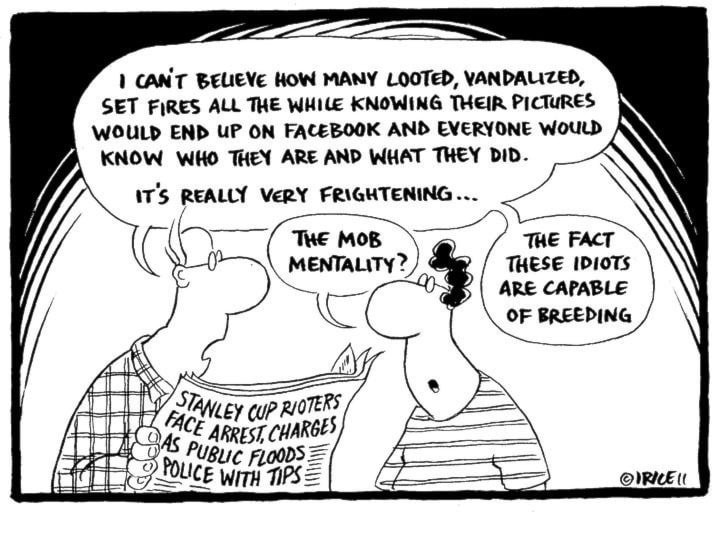It was just over 39 years ago that I got my first taste of a violent riot in Vancouver, and learned a few lessons that apply to the ongoing discussion over what officials should do in the aftermath of the 2011 Stanley Cup riot.
My buddies and I were newly graduated from high school and all aged 18 when we decided to drive into Vancouver and try to pick up some scalper’s tickets to the sold out Rolling Stones concert at the Pacific Coliseum on June 3, 1972.
Tickets were priced at $6 each at the time but each of us had up to $20 in our pockets for a ticket. However, there were a couple of thousand people milling about outside the Coliseum when we arrived, apparently all of them with similar hopes of scoring a scalper’s ticket.
Worse, it was starting to get ugly. Some were inciting us to try to rush the gates and crash our way in, and then suddenly there were rocks flying.
This was our cue to get out of Dodge, or Vancouver to be more accurate. It was obvious that things were going to deteriorate fast and there was no hope of finding a legitimate ticket in the ensuing bedlam.
We were all country kids, used to working on the farms, and considered ourselves “jocks” who liked to work out at the boxing club or in the gymnasium or sports field with the sports teams. We had teen bravado, were full of testosterone and afraid of no one. However, this was no “sport” unfolding before our eyes, this was pure insanity, and we wanted no part of it.
So we walked back to our car, parked around the corner from the Coliseum, and we timed it just right. Just as we got into the car we could see the line of Vancouver City Police, mounted on horses, shout out a warning on megaphones and take their first charge at the rioters, who were throwing rocks, and as we found out later, also molotov cocktails.
Later on the news we heard that about 30 policemen were hospitalized, and several dozen of the 2,000-strong crowd which refused to disperse were arrested on various charges.
A few of the convicted rioters served time in Oakalla prison for throwing rocks and molotov cocktails, despite protestations of innocence from several of them. Two of them were from Langley and there was considerable controversy because one was the son of a respected, mild-mannered Langley school district high school counsellor.
But it was hard to feel any sympathy for them, as they should have known better than to stick around when things started going sour at the Coliseum.
In the aftermath of it all politicians were talking about banning the Rolling Stones and other rock bands from performing in Vancouver, and there were a variety of theories about anarchist groups and the notorious Vancouver “Clark Park Gang” being instigators of the riot.
I have no idea whether the riots were organized — it seemed dreadfully disorganized in my view — but in the months that followed the police did crack down mightily on the Clark Park Gang, and there was general agreement among the public that this was overdue anyway.
And of course, the rock concerts and major events continued to occur in Vancouver, and things remained pretty well on an even keel until the 1994 Stanley Cup riot.
It’s apparent from watching the video footage of the 2011 riot that while there may have only been a handful of persons doing the damage to persons and property there were far too many people who should have left the scene and who were egging the hotheads on.
These people are just as much at fault as the persons who threw rocks or lit fires, in my view.
If you don’t have enough sense of self-preservation to get out of harm’s way as quickly as possible (and all three of my hockey-loving children and their spouses were downtown and managed to get out of the crowds in plenty of good time), frankly you deserve whatever punishment you get.
